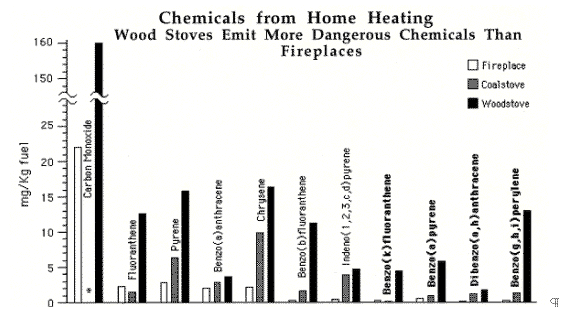

Carcinogenic Chemicals from Wood and Coal Stoves: to compare carcinogens produced by a fireplace, a coal stove and a wood stove (Zeedijk, 1985).
In addition to producing fine particulate pollution, stoves and fireplaces burning wood and coal produce Polycyclic Aromatic Hydrocarbons (PAH). PAH are known to cause cancer.
It is the way that you burn wood and what wood you burn that
effects the composition and volume of the smoke. A fireplace has
an excess of air and oxygen. A wood stove or coal stove is air
(oxygen) starved. This design (dating from Ben Franklin) causes
the wood stove to produce more energy but also more carcinogens,
PAH.

*The CO is on a different scale. Note the CO figure for wood stoves is in grams/kilogram. (Larson and Koenig report CO as 80-370 g/kg of wood.)
Newer airtight wood stoves keep more of the carcinogens out
of the burners living space, however they deliver more carcinogens
to the burners neighbors. One wood stove in one hour, produces
approximately 4,300 times more PAH than thirty cigarettes (Larson,
1993) (Ott, 1999). Burning two cords (a cord of wood is a pile
which measures 8 feet by 4 feet by 4 feet.) of wood produces the
same amount of mutagenic particles as driving 13 gasoline powered
cars 10,000 miles @ 20 miles per gallon (Lewtas, 1991).
In the San Francisco Bay Area a winter trend of increased mutagenic
activity in tested air samples was spotted in the early 1980's.
Winter samples were three to nine times more mutagenic than during
other seasons. Cleaner cars helped lower the PAH but not the overall
mutagenicity of the winter air (Flessel, 1991).
Back to Burning Issues